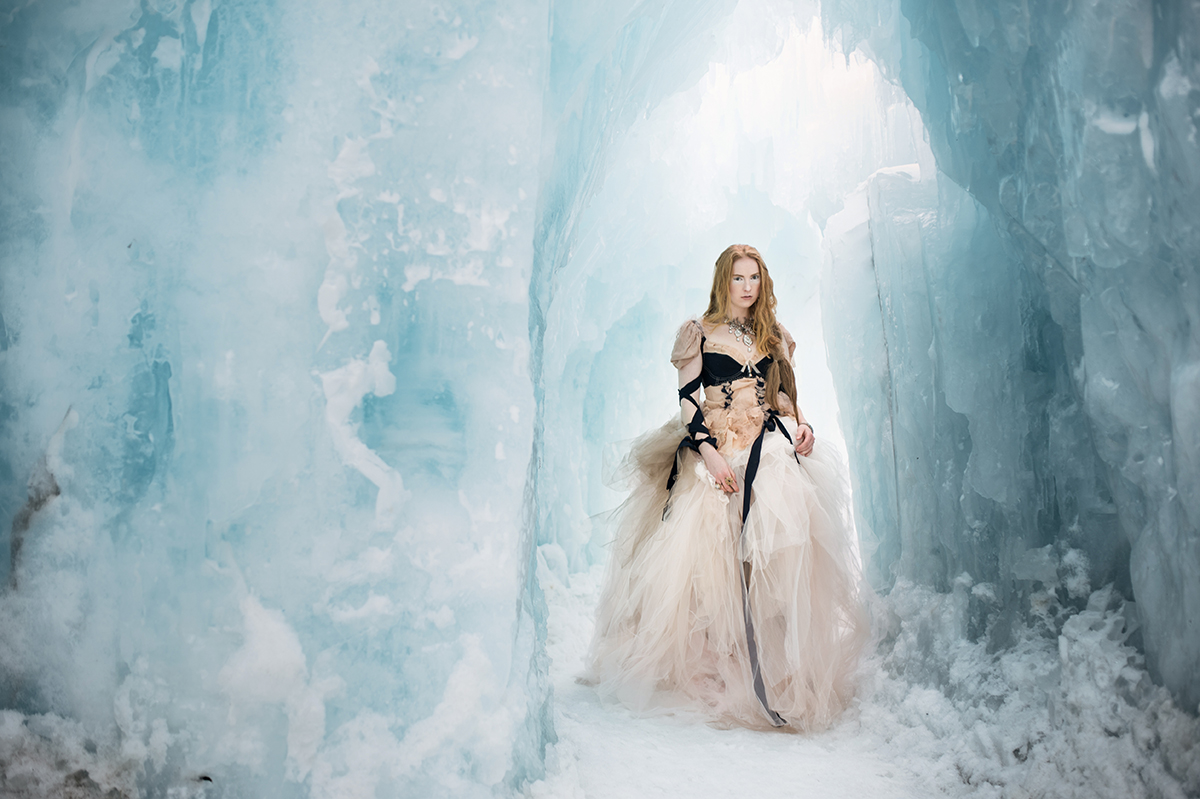Images Among the Icicles
Robin Fulton freezes moments in time in the literally frozen Ice Castles with her Tamron SP 70-200mm VC G2 and SP 24-70mm VC G2 lenses.
More Photo Tips | Video Gallery | Photo Gallery | Enewsletter sign-up
By Jenn Gidman
Images By Robin Fulton
With its hot springs, northern lights, and glacial paradises to explore, Iceland has become an in-vogue locale for wandering photographers. Robin Fulton knew she wouldn't be traveling to the Land of Fire and Ice anytime soon, though, so she instead arranged for a photo shoot at the next best thing: a "land" of just ice. That would be the Ice Castles, a frozen installation that pops up in a handful of cold-weather cities around the US and Canada. Each structure grows to weigh up to 25,000,000 pounds, with 10-foot-thick walls, and visitors stroll through the installment to admire the icicle-themed artistry, illuminated with colored lights that are embedded throughout.
"Visiting the Ice Castles here in Colorado was a way to capture some dramatic photos right in my own backyard," Robin says. "A friend of mine had done an Ice Castles shoot a few years ago, and I was drawn in by how his photos came out: The ice was super-blue and the model's face was very warm. I remember seeing that and thinking, 'I have got to shoot at this place.'"
For her own visit to the Ice Castles, Robin used the Tamron SP 70-200mm VC G2 and SP 24-70mm VC G2 lenses. "I love the 70-200 because its versatility allowed me to zoom in on my model when I wanted to capture a close-up, but pull back when I wanted to capture more of the ice in the scene with her," she says. "Plus, when you're handholding in an installation like this, where you're outside and shivering from the cold, it's hard to keep your camera from slightly shaking. The Vibration Compensation (VC feature) on both of these lenses helped keep blur out of my photos, even at slower shutter speeds. The clarity on these two lenses is also superb. When I'm taking a portrait with the 24-70, you can see every one of the model's eyelashes when I zoom in."
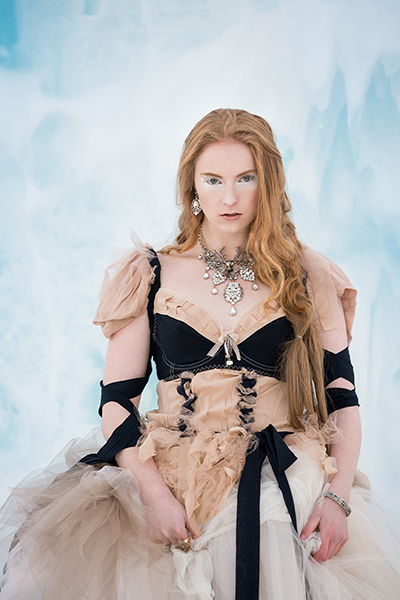
165mm, f/2.8, 1/200 sec., ISO 100
Click image to view larger
Because the Ice Castles are constructed outdoors in the winter—they're usually erected just before Christmas and remain up until around Valentine's Day—shooting conditions can be uncomfortable. "I'm accustomed to working in the cold, because I used to shoot weddings in the ski areas," Robin says. "I've had severe frostbite on my fingers in the past, and my trigger finger will sometimes not have feeling when it gets that cold. So I have to be really careful to keep my hands toasty. I couldn't keep going inside elsewhere to warm up when I was photographing the Ice Castles, because my lenses would have fogged up, so I relied on pocket warmers to keep my hands in working condition."
Because Robin knew everything inside the Ice Castles would have a pale blue cast, she tasked her makeup and costume designer with coming up with outfits and makeup that would provide an appealing contrast. "We had no clue ahead of time whether it was going to be sunny or cloudy on the day of the shoot, but we did know the ice would have a jagged look to it, so I didn't want my model to be decked out in something traditionally beautiful," Robin says. "I wanted apparel that had a bit more of a tattered look, to match with the ice, and my designer really came through."
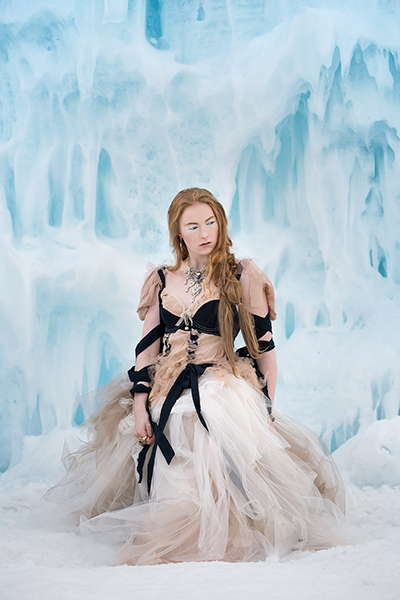
70mm, f/2.8, 1/250 sec., ISO 100
Click image to view larger
The young model Robin worked with on this shoot was familiar with working in the cold, thanks to her professional snowboarding background. "But she's mainly done sports-themed photo shoots, so she's more used to aggressive, competitive facial expressions," Robin explains. "And she was so cold throughout the shoot—I think she gulped down three hot chocolates after we finished. So she was shivering, her brow was furrowed, and it was a little more difficult to get her to look 'soft' during this session."
That's where Robin's coaching experience came into play. "I coach both photographers and models on how to work through a shoot—some photographers may be intimidated by professional models, and greener models may not know instinctively what to do," she explains. "One thing I'll tell both photographers and models is to relax and breathe. As a photographer, I tend to hold my breath when I'm shooting handheld, and I know many models do the same."
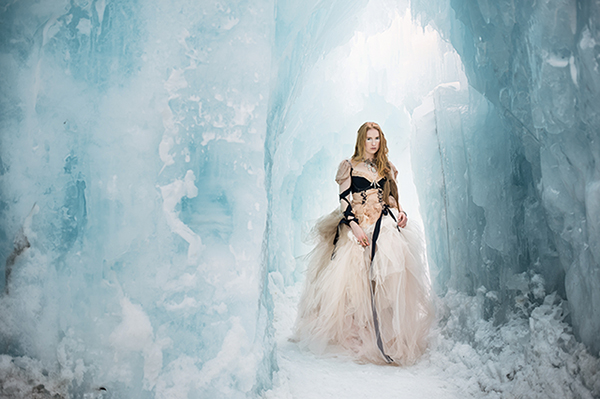
35mm, f/2.8, 1/50 sec., ISO 100
Click image to view larger
When models do that, they tend to purse their lips and make other facial expressions that don't make for an ideal image. "If you're tense and not breathing, or even cold like this model was, it's going to show in your jaw, in your mouth, and in your eyes," Robin says. "That was one of my mandates here: to make sure my model was as relaxed and comfortable on set as possible. And though she's a mountain kid and is used to a more frigid environment, we had one person on set specifically there to help keep her warm. She was in and out of a coat the entire time, in between shots. Plus, once in a while I'd say to her, 'You got this.' Even if your model doesn't 'got this,' you have to impress that into her and turn it into a self-fulfilling prophecy. Confidence can go a long way."
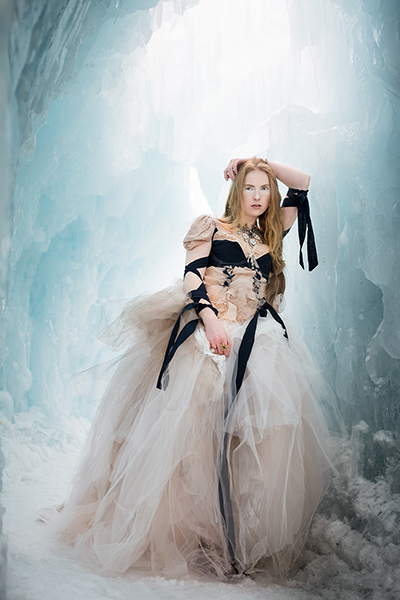
35mm, f/2.8, 1/60 sec., ISO 100
Click image to view larger
One of Robin's biggest challenges was dealing with the crowds, as well as the time and space restraints inside the Ice Castles. "You're allowed to take pictures inside, but you're not allowed to set up a formal shoot where you have the whole place to yourself," she explains. "There were tourists everywhere; we couldn't stay in one spot for longer than two minutes. And they have workers there whose job is to constantly move people along. Our entire shoot took about an hour—we walked through the installation, took as many quick photos as we could at each interesting vantage point, then circled back through a second time."
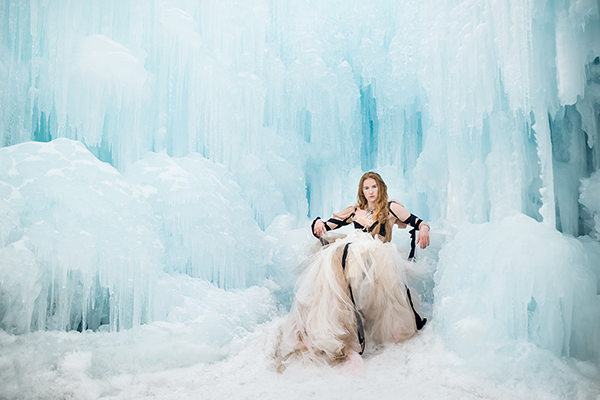
35mm, f/2.8, 1/100 sec., ISO 100
Click image to view larger
Because of the necessity of constantly being on the move, Robin couldn't have an elaborate lighting setup. "I knew going in that getting those skin tones right was going to be challenging, considering the circumstances," she says. "To supplement the natural light that streamed in at certain spots, I used a portable ice light, an SB-800 Nikon Speedlight, and a reflector. As we lost daylight, I had to rely on the ice light more and more, because I wasn't really supposed to be using the flash inside. I also couldn't use a tripod, obviously, or bring in an external battery or giant bag. I was allowed just a backpack."
Robin used auto white balance, tweaking it in post-production. "That's not what I usually like to do, but it's what I had to do in this case," she says. "I couldn't keep calibrating it every single time. This was the hardest part of the shoot: getting my model's skin tones to look human, because compared to the daylight balance on the ice light and the exaggerated blue color they ran through into the ice, my model's skin looked orange—and this is a kid who's super-pale as can be. The internal white balance was trying to compensate for the pervading blue tones surrounding her. Yet in post, when I'd try to bring down the orange in her skin, her red hair would go flat. It took a lot of hard work to subtly adjust each picture, because every one was different."
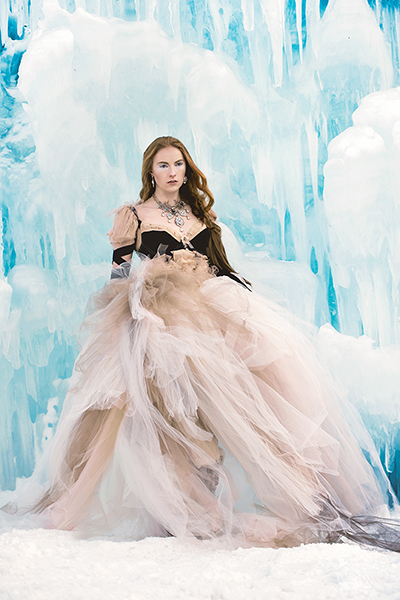
78mm, f/3.2, 1/160 sec., ISO 100
Click image to view larger
Although Robin carried out this project mainly to test-drive her Tamron lenses, she made sure to do double duty. "I always submit to fashion magazines after a shoot like this," she says. "And so I made sure to take a variety of photos that told a story: headshots, three-quarter photos, full-length images, and wider shots. Plus everyone on my team is looking for images that showcase what they've contributed to the shoot: My clothing designer will naturally want a bunch of full-length shots showing off the dress, while my model may want close-ups of her face."
That's where the versatility of Robin's Tamron lenses truly proved invaluable. "From my early days photographing weddings, I learned to constantly vary my shooting perspectives, angles, and compositions," she says. "I never take all of my photos from the same height, for instance, and I'm always looking to change my horizon line. With just these two lenses, I was able to achieve so many different types of looks. Go wide, zoom in, zoom back out—the possibilities in the Ice Castles were almost endless, even despite the time and space constraints we were working with."
To see more of Robin Fulton's work, go to www.robins.photography.
More Photo Tips | Watch Videos | Learn More About Tamron Lenses | Photo Gallery
